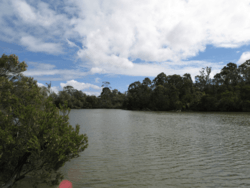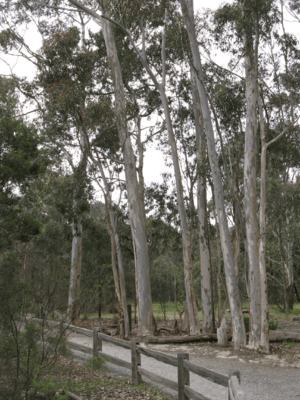Blackburn Lake Sanctuary facts for kids
Quick facts for kids Blackburn Lake Sanctuary |
|
|---|---|

Blackburn Lake, looking south
|
|
| Type | Public Park |
| Location | Melbourne |
| Area | 30 ha (74 acres) |
| Established | 1889 |
| Operated by | City of Whitehorse |
| Status | Open |
| Paths | Unsealed bush paths |
| Terrain | Bushland, lake |
| Water | Blackburn Lake, Kooyongkoot Creek |
| Vegetation | Australian native plants, wildflower farm, palm trees |
| Connecting transport | Train, bus, car |
| Facilities | Toilets, playground, visitors centre, seating and shelters |
Blackburn Lake Sanctuary is a special place in suburban Melbourne, Australia. It shows what bushland used to look like and how it can grow back. You can find it in the suburb of Blackburn. It is one of the most important parks in the City of Whitehorse. It has many areas of regrown bushland and lots of walking tracks.
In 1889, a dam was built across Kooyongkoot Creek. This created Blackburn Lake, which is the heart of the sanctuary. The park has a long history of people using the lake and the bushland. By the 1960s, the lake had become very dirty.
Today, the lake is still affected by past pollution. However, in recent years, local people and groups have worked hard. They have planted many new plants and protected the area. This has helped to stop and even reduce the pollution. Now, the park is home to many local animals. You can see Pacific black ducks, herons, and other birds. There are also possums and sugar gliders living here.
Contents
Discovering Blackburn Lake's Past
Blackburn Lake was created in 1889. A dam was built on Gardiners Creek to provide water for local fruit farms. The lake quickly became a popular spot for visitors. People would travel from Melbourne by steam train to enjoy the area.
In the 1890s, a famous artist named Frederick McCubbin lived near the lake. He was part of the Heidelberg School of artists. He painted some of his well-known works here. These include "Down on His Luck" and "Bush Idyll".
In 1909, the Adult Deaf Society bought the land around the lake. They built a special home and a flower farm there. Later, in 1964, the Society sold the lake and land to the Melbourne Water board. The area was officially made a sanctuary in 1965. More land was bought by the public over time. The sanctuary reached its current size in 1992. The Visitor Centre was updated in 1991. This allowed for more education programs.
Exploring the Park's Geography
The park covers about 30 hectares (74 acres) of land. It is right in the middle of Blackburn. This suburb is about 18 kilometres (11 mi) east of Melbourne's city centre.
How Blackburn Lake Was Formed
Before the lake existed, Kooyongkoot Creek flowed through the valley. It started in Mitcham and went through Blackburn. Many small streams joined it, especially in winter. You can still see some of these old stream beds today. In summer, the creek sometimes dried up.
The lake was created in 1889 by building a dam. It first provided water for fruit growers. Over the years, it was used for many different things. Today, activities on the lake are limited. This helps to protect the plants and animals around it. Small creeks from the east feed the lake. Many small gullies also bring water. The dam wall is on the west side of the lake. Lake Road runs along the top of this wall. From the wall, Kooyongkoot Creek continues its journey west.
The lake was once about 50 feet (15 m) deep. This was where the creek had been mined for a mineral called antimony. But studies show it is not that deep now. It has filled up with silt over the years. In the 1920s, people used to swim and have diving towers here. The water was clean back then. The Blackburn Swimming Club closed in 1931 because of damage to its facilities.
In the 1950s and 1960s, the lake was used as a dumping ground. Old car parts and other rubbish were thrown in. This caused harmful substances to leak into the water. Today, the lake water cannot be used for drinking or farming. In 1962, a new dam wall was built on Lake Road. This was to help prevent floods further down Kooyongkoot Creek. The old Lake Road Bridge was removed in 1965.
There are several bridges that cross the lake and its creeks:
- Friends Bridge (built in the early 1900s, rebuilt in 1981)
- Billabong Bridge (built in the 1980s)
- Lake Road Bridge (built in 1888, removed in 1965, rebuilt in 2002)
Enjoying the Sanctuary: Recreation and Nature
In the past, most fun activities at the park happened around the lake. But now, people enjoy the park by appreciating the Australian native plants. Many of these plants have grown back over time. The park is very popular with people who love to go bushwalking. Cycling is also enjoyed by locals. However, the park does not have a special path for cyclists to ride all the way through.
Getting to Blackburn Lake Sanctuary
You can enter the park from several streets:
- Central Road
-
- Gwenda Avenue (This is the main entrance with a car park)
- Fulview Court
- Cromwell Court
- Lake Road
-
- Jeffery Street
- Naughton Grove (near the dam wall)
- Halley Street (also near the dam wall)
- Ottawa Avenue
- Clifton Street
-
- Via the Playground



